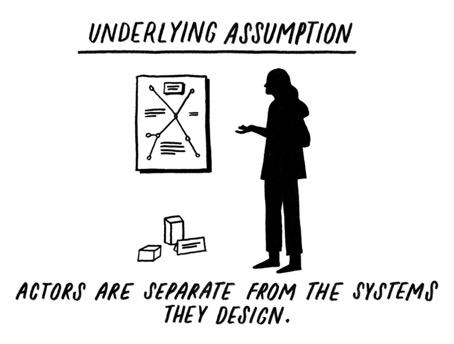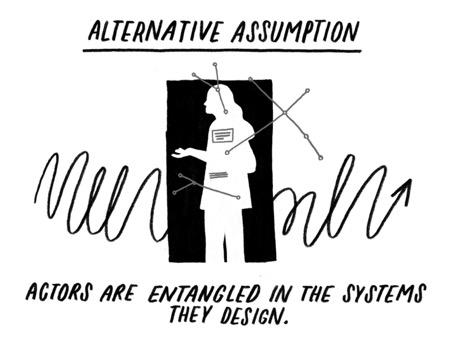CTF blog: Designing the Systemic Self
2018-09-27There is a shift happening within service design from designing something "out there" to designing ourselves. This shift opens up questions about how we might design our "systemic-self" and what new approaches we need to do so.
In service design, there is often a focus on mapping the service systems we wish to change. We create personas, draw user journeys and plot out the different stakeholders. While the process of visualizing these service systems is critical for supporting dialogue and reflection, all too often these approaches frame the service system as something “out there”.
Service design tends to over-emphasize empathizing with some (often hypothetical) other, rather than integrating our own lived experience (read more here). As such, we often fail to fully recognize the ways in which we are upholding and shaping service systems through our own thoughts and actions. Next, the sentiment develops that others need to change to improve or transform the service system.
Ultimately, there is an underlying assumption that we are separate from the systems we design. This false dichotomy between those designing and what is being designed contributes to a superficial understanding of service design that is not fully reflective of the contextual struggles. Furthermore, without addressing this assumption, we risk inadvertently replicating core aspects of the provider-centric, paternalistic and colonial systems we seek to transform.
At the same time, within design literature, there is growing acknowledgement that “we design our world, while our world acts back on us and designs us” (Willis, 2006). Aligned with this notion, recent discussions in service research have called out the feedback loop in service ecosystems where actors shape taken-for-granted institutions (e.g. rules, norms, roles) and those institutions continue to influence actors (Vargo & Lusch, 2017). Within design practice and education, there are also some folks doing interesting work on designing from the inside out (see the work of Fit Associates for examples). As a result, an alternative assumption is emerging that actors are, in fact, entangled in the systems they design. In this way, we are not designing something “out there” but rather we are designing ourselves.
In my research in the Swedish healthcare system with Experio Lab, I have been exploring alternative approaches to service design that focus on designing the systemic self. The concept of the systemic self is borrowed from work on critical reflective practice by Ekua Andria C. Walcott, Akua Benjamin and Jana Vinsky. Our systemic self includes our thoughts and actions that are influenced by and influence the service systems we are apart of. It is our systemic selves that hold the current structures in place and make systemic transitions so challenging.
For example, when redesigning the doctor-patient relationship to be a partnership between equals, we need to recognize the ways in which we are upholding outdated mental models like “the doctor knows best” through our thoughts and actions. Using ethnographic approaches and ‘research through design’, I have been investigating how we can build awareness of our systemic selves and reflect on the ways in which we are already designing the service systems were in.
Are you interested in finding out some of the results of my research?
Stay tuned! I’ll be sharing some of my experiments and findings soon. Have you been doing work related to designing the systemic self? I would love to hear about it! Email me at josina.vink@kau.se, follow me on Research Gate, or connect with me on twitter @josinavink
Josina Vink is a designer and researcher exploring how people can shape the social structures of health and care. She is a PhD Student at CTF and works as an embedded design researcher at Experio Lab, County Council of Varmland, Sweden. She is also a Research Fellow in the European Union's Service Design for Innovation Network (SDIN).







